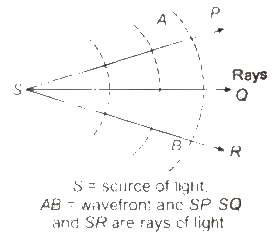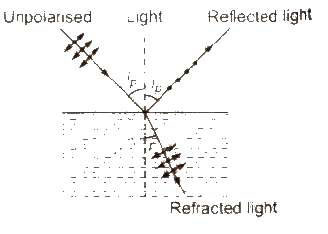
physics notes for class 12 download pdf chapter 10: wave optics, wave optics 12 notes, class 12 physics notes, wave optics class 12, wave optics class 12 notes, class 12 wave optics, note physics, physics notes, wave optics, class 12 cphysics chapter 10 notes, 12th standard physics notes, 12th std physics notes, class 12 physics notes chapter 10, wave optics chapter class 12 notes
Wave optics describes the connection between waves and rays of light. According to wave theory of light, the light is a form of energy which travels through a medium in the form of transverse wave motion. The speed of light in a medium depends upon the nature of medium.
Light consists of very small invisible elastic particles which travel in vacuum with a speed of 3 x 108 m/s.
The theory could explain reflection and refraction.
The size of corpuscular of different colours of light are different.
It could not explain interference, diffraction, polarisation. photoelectric effect and Compton effect. The theory failed as it could not explain why light travels faster in a rarer medium than in a denser medium.
A wavefront is defined as the continuous locus of all the particles of a medium, which are vibrating in the same phase.
These are three types
(i) Spherical wavefront
(ii) Cylindrical wavefront
(iii) Plane wavefront

Light travel in a medium in the form of wavefront.
A wavefront is the locus of all the particles vibrating in same phase.
All particles on a wavefront behaves as a secondary source of light, which emits secondary wavelets.
The envelope of secondary wavelets represents the new position of a wavefront.
When source of light is a point source,the wavefront is spherical.
Amplitude (A) is inversely proportional to distance (x) i.g., A ∝ 1 / x .
∴ Intensity (I) ∝ (Amplitude)2
When SOurce of light is linear, the wavefront is cylindrical.
Amplitude (A) ∝ 1 / √x
∴ Intensity ∝ (Amplitude)2 ∝ 1 / x
(i) Every point on given wavefront (called primary wavefront) acts as a fresh source of new
disturbance called secondary wavelets.
(ii) The secondary wavelets travels in all the directions with the speed of light in the medium.
(iii) A surface touching these secondary wavelets tangentially in the forward direction at any
instant gives the new (secondary) wave front of that instant.
(i) Light waves are electromagnetic waves which do not require a material medium for their
propagation.
(ii) Due to transverse nature, light wave undergo polarisation.
(iii) The velocity of electromagnetic wave in vacuum is c = 1 / √μo εo
(iv) The velocity of electromagnetic waves in medium is less than that of light, v < c
v = 1 / √μo εo εr μr = c / √μo εr
(v) The velocity of electromagnetic waves in a medium depend upon the electric and magnetic
properties of the medium.
where, μo = absolute magnetic permeability and εo = absolute electrical permittivity of free space.
(vi) It failed to explain the phenomenon of photoelectric effect, Compton effect and Raman effect.
(i) Light emits from a source in the form of packets of energy called quanta or photon.
(ii) The energy of a photon is E == hv, where h is Planck’s constant and v is the frequency of light.
(iii) Quantum theory could explain photoelectric effect, Compton effect and Raman effect.
(iii) Quantum theory failed to explain interference, diffraction and polarisation of light.
Light waves have dual nature, wave nature according to Maxwell’s electromagnetic wave theory and particle nature according to Max-Planck’s quantum theory.
Two natures of light are like the two faces of a coin. In anyone phenomena only its one nature appears.
Energy of photon = hv = hc / λ
where, h = Planck’s constant 6.6 * 10<sup-34 J / s
de-Broglie wave equation is λ = h / p = h / mv
where h denotes Planck’s constant.
When two similar waves propagate in a medium simultaneously, then at any point the resultant displacement is equal to the vector sum of displacement produced by individual waves.
y = y1 + y2
When two light waves of similar frequency having a zero or constant phase difference propagate in a medium simultaneously in the same direction, then due to their superposition maximum intensity is obtained at few points and minimum intensity at other few points.
This phenomena of redistribution of energy due to superposition of waves is called interference of light waves.
The interference taking place at points of maximum intensity is called constructive interference.
The interference taking place at points of minimum intensity is destructive interference.
The distance between the centres of two consecutive bright or dark fringes is called the fringe width.
The angular fringe width is given by θ = λ / d.
where λ is the wavelength of light d is the distance between two coherent sources.
Phase difference, φ = 2nπ
Path difference, Δx = nλ
where, n = 0, 1, 2, 3,…
Phase difference, φ = (2n – 1)π
Path difference, Δx = (2n – 1)π / 2
where, n = 1, 2, 3, …
If two waves of exactly same frequency and of amplitude a and b interfere, then amplitude of resultant wave is given by
R = √a2 + b2 + 2ab cos φ
where φ is the phase difference between two waves.
Rmax = (a + b)
Rmin = (a – b)
Intensity of wave
∴ I = a2 + b2 + 2ab cos φ
= I1 + I2 + 2 √I1 I2 cos φ
where I1 and I2 are intensities of two waves.
∴ I1 / I2 = a2 / b2 = ω1 / ω2
Where ω1 and ω2 are width of slits.
Energy remains conserved during interference.
Interference fringe width
β = Dλ / d
where, D = distance of screen from slits, λ = wavelength of light and d = distance between two slits.
Distance of nth bright fringe from central fringe xn = nDλ / d
Distance of nth dark fringe from central fringe x’n = (2n – 1) Dλ / 2d
The sources of light emitting light of same wavelength, same frequency having a zero or constant phase difference are called coherent sources of light.
When a transparent sheet of refractive index μ and of thickness t is introduced in one of the path of interfering waves, then fringe pattern shifts in that direction by a distance Y
Y = D / d (μ – 1) t = β / λ (μ – 1) t
where, β = fringe width.
It is a combination of two prisms of very small refracting angles placed base to base. It is used to obtain two coherent sources from a single light source.
The shape of interference fringes are usually hyperbolic.
When screen is held at 900 to the line joining foci of the hyperbola, the fringes are circular.
When distance of screen (D) is very large compare to the distance between the slits (d), the Cringes are straight.
The bending of light waves around the corners of an obstacle or aperture is called diffraction of light.
The phenomenon of diffraction is divided mainly in the following two classes
(a) Fresnel class
(b) Fraunhofer class
S.No Fresnel Class |
Fraunhofer Class |
| The sourceis at a finite distance | The source is at infinite distance |
| No optJcals are required. | Opticals are in the form of Collimating lens and focusing lens are required. |
| Fringes are not sharp and well defined. | Fringes are sharpand well defined. |
Linear Width 0f central maximum 2Dλ / a = 2fλ / a
Angular width of central maximum = 2λ / a
where, λ = wavelength of light, a = width of single slit, D = distance of screen from the slit and f = focal length of convex lens.
(a) Path difference = nλ
(b) Linear distance = nDλ / a = nfλ / a
(c) Angular spread = nλ / a
where, n = 1, 2, 3,.,.
(a) Path difference = (2n + 1 ) &lamda; / 2
(b) LInear distance = (2n + 1 ) D&lamda; / 2a = (2n + 1 ) f&lamda; / 2a
(c) Angular spread = (2n + 1 ) &lamda; / 2
• A soap bubble or oil film on water appears coloured in white light due to interference of
light reflected from upper and lower surfaces of soap bubble or oil film.
• In interference fringe pattern all bright and dark fringes are of same width,
• In diffraction fringe pattern central bright fringe is brightest and widest. and I remaining
secondary maximas are of gradually decreasing intensities.
• The difference between interference and diffraction is that the interference is the
superposition between the wavelets coming from two coherent sources while the
diffraction is the superposition between the wavelets coming from the single wavefront
The phenomena of restructuring of electric vectors of light into a single direction is called polarisation.
Ordinary light has electric vectors in all possible directions in a plane perpendicular to the direction of propagation of light.
When ordinary light is passed through a tourmaline, calcite or quartz crystal the transmitted light have electric vectors in a particular direction parallel to the axis of crystal. This light is plane polarised light.
[A plane containing the vibrations of polarised light is called plane of vibration.
A plane perpendicular to the plane of vibration is called plane of polarisation.]
Polarisation can take place only in transverse waves.
A nicol prism is an optical device which is used for producing plane polarised light and analysing light the same.
The nicol prism consists of two calcite crystal cut at 68° with its principal axis joined by a glue called Canada balsam.
When a beam of completely plane polarised light is incident on an analyser, the intensity of transmitted light from analyser is directly proportional to the square of the cosine of the angle between plane of transmission of analyser and polariser, i.e.,
I ∝ cos2 θ
When ordinary light is incident on a polariser the intensity of transmitted light is half of the intensity of incident light.
When a polariser and analyser are perpendicular to each other, then intensity of transmitted light from analyser becomes O.
When unpolarised light is incident at an angle of polarisation (ip) on the interface separating air from a medium of refractive index μ, then reflected light becomes fully polarised, provided
μ = tan ip

If angle of polarisation is ip and angle of refraction is μ then ip + r = 90°
Refractive index μ = tan ip = 1 / sin C
where, C = critical angle.
When unpolarised light is incident on a calcite or quartz crystal it splits up into two refracted rays. one of which follows laws of refraction. called ordinary ray (O-ray) and other do not follow laws of refraction. called extraordinary ray (E-ray). This phenomena is called double refraction.
Few double refracting crystals have a property of absorbing one of the two refracted rays and allowing the other to emerge out. This property of crystal is called dichroism.
It is a polarising film mounted between two glass plates. It is used to produce polarised light.
A polaroid is used to avoid glare of light in spectacles.
(i) Polaroids are used in sun glasses. They protect the eyes from glare.
(ii) The polaroids are used in window panes of a train and especially of an aeroplane. They help
to control the light entering through the window.
(iii) The pictures taken by a stereoscopic camera. When seen with the help of polarized spectacles, create three dimensional effect.
(iv) The windshield of an automobile is made of polaroid. Such a mind shield protects the eyes
of the driver of the automobile from the dazzling light of the approaching vehicles.
Copyright @ ncerthelp.com A free educational website for CBSE, ICSE and UP board.